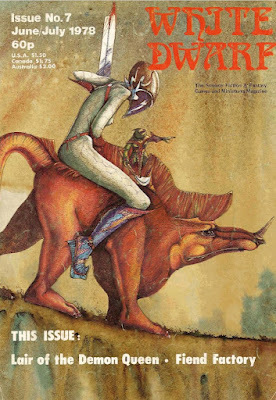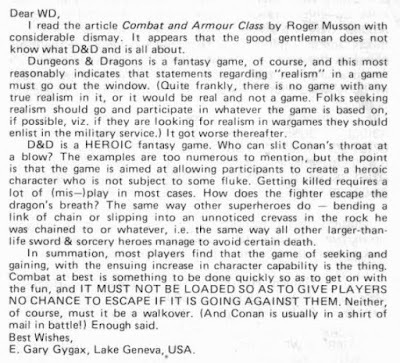White Dwarf: Issue #7
 Issue #7 of White Dwarf (June/July 1978) represents something of a milestone for the British gaming periodical. Firstly, it marks the start of the second year of its publication. Secondly, it's the first issue to feature a full-color cover (by the ever-amazing John Blanche). In his opening editorial, Ian Livingstone draws the reader's attention to both of these facts – facts he believes serve as "a reminder to traditional wargamers that we (i.e. roleplayers) are a serious part of the hobby and not just a weird, temporary deviation from it." As ever, I find such comments very strange, but then I was never a wargamer (take a drink), nor did I much care about their opinion of what seemed to me to be a related but wholly separate hobby. Mind you, I was a 10 year-old child when I discovered D&D rather than an adult like Livingstone, so I suppose I can be forgiven for not understanding his seemingly interminable concern about the reputation of roleplaying in wargaming circles. If nothing else, it's a reminder that the past truly is another country.
Issue #7 of White Dwarf (June/July 1978) represents something of a milestone for the British gaming periodical. Firstly, it marks the start of the second year of its publication. Secondly, it's the first issue to feature a full-color cover (by the ever-amazing John Blanche). In his opening editorial, Ian Livingstone draws the reader's attention to both of these facts – facts he believes serve as "a reminder to traditional wargamers that we (i.e. roleplayers) are a serious part of the hobby and not just a weird, temporary deviation from it." As ever, I find such comments very strange, but then I was never a wargamer (take a drink), nor did I much care about their opinion of what seemed to me to be a related but wholly separate hobby. Mind you, I was a 10 year-old child when I discovered D&D rather than an adult like Livingstone, so I suppose I can be forgiven for not understanding his seemingly interminable concern about the reputation of roleplaying in wargaming circles. If nothing else, it's a reminder that the past truly is another country.
The issue begins with an article written by Ed Simbalist entitled "Feudal Economics in Chivalry & Sorcery." It's an interesting enough piece, especially for those who want to more "realistically" model the economics of the European Middle Ages in their campaign settings. More interesting than its content, though, is the fact that it's penned by one of the creators of C&S. If nothing else, Simbalist's appearance in WD's pages show that, after only a year of publication, it had already begun to attract significant attention on the other side of the Atlantic. "Fiend Factory" offers up nine new monsters for D&D, several of which would later appear in the Fiend Folio. None of those featured could be called "classics," even by the odd standards of the Fiend Folio, though a handful deserve comment. The first is the Rover, based on the bouncing ball from The Prisoner. The second is the Gluey, which was renamed the Adherer in its published FF form. Finally, there's the Squonk, based on the legendary monster of northern Pennsylvania, which the text calls "more of a pet than a monster; perhaps the female D&Ders would take more to this beast than the hard-headed males."
The "Letters" column is notable for one letter, commenting on Roger Musson's article in issue #6. I reproduce it here in its entirety.
 One of these days, I'll need to collect together as many Gary Gygax quotes as I can find regarding the matters of "realism" and "heroism" in D&D to see how consistent his position on the matter remained over the years. For now, I'll simply say that, as he often does, Gygax speaks here in such an argumentative and disingenuous fashion that, even if one were inclined to agree with his points (which I mostly do), he makes it hard to do so, lest one be seen as similarly intemperate. I can't help but wonder how different the history of the hobby might have been if the younger Gygax had possessed even a small portion of the equanimity his older self possessed.
One of these days, I'll need to collect together as many Gary Gygax quotes as I can find regarding the matters of "realism" and "heroism" in D&D to see how consistent his position on the matter remained over the years. For now, I'll simply say that, as he often does, Gygax speaks here in such an argumentative and disingenuous fashion that, even if one were inclined to agree with his points (which I mostly do), he makes it hard to do so, lest one be seen as similarly intemperate. I can't help but wonder how different the history of the hobby might have been if the younger Gygax had possessed even a small portion of the equanimity his older self possessed.John T. Sapienza's "Carrying Capacity" offers a short and relatively simple new encumbrance system that uses a character's Strength to determine what percentage of his body weight he can carry in equipment and treasure. Meanwhile, Brian Asbury provides Part III of his "Asbury System" for experience. This time, he gives readers the means to determine the XP value of magic weapons and armor, based on their types (sword, mace, chain, plate, etc.), bonuses, and other abilities. I can see no obvious problem with his system as such, only that it seems like more trouble than it's worth, especially when the Dungeon Masters Guide already does the work for the referee (though, to be fair, at the time of publication of this issue, the DMG was still more than a year in the future).
"Molten Magic" provides photographs for eight different sets of miniature figures, including those by Ral Partha and Asgard. "Open Box," meanwhile, features reviews for The Warlord Game, The Thieves of Fortress Badabaskor, Bifrost Volume 1, Lords and Wizards, The Sorcerer's Cave, and Cosmic Encounter. There's also another installment of the "Kalgar" comic strip, which continues to do little for me. I find myself looking forward to the future, when other strips more familiar to me will appear, but those won't, I fear, appear for quite some time still.
Don Turnbull's "Lair of the Demon Queen" presents a "difficult but rewarding section" of his Greenlands Dungeon for the delectation of readers. The lair is a fairly small section of said dungeon but it's quite well thought out, with an elaborate trap that requires deciphering a poem (spoken by statues with magic mouths) to overcome. I simply adore rooms like this in dungeons and I'm ashamed when I consider how much more straightforward my own chambers tend to be these days. In my youth, I'd devote much thought to tricks and traps, not to mention riddles, rhymes, and other bits of fantasy nonsense intended to aid and befuddle the players. Reading this article reminded me of how far I've fallen in the years since. Perhaps I shall have to rectify this in my future work.
The issue ends with "Thoughts on the Proliferation of Magic Items in D&D" by none other than Gary Gygax. As one might expect, Gygax is very much opposed to what he calls "magic on the cheap," something he claims is quite common in "hobby publications" at the time. He suggests that, since D&D is "designed for a long period of active play," the referee would be wise to give out magic items sparingly and with an eye toward ensuring that the game remain challenging over time. He then offers many strategies for separating PCs from magic treasure so as to maintain the appropriate balance. Everything he says here comports with his writings on the subject elsewhere, but, as I commented earlier, his tone is condescendingly off-putting at times and I fear it might sometimes get in the way of what he intends to say (Physician, heal thyself).
Issue #7 of White Dwarf was, by and large, enjoyable to me. It's definitely step up in terms of presentation and quality over its immediate predecessors and it gives me hope that the upcoming issues will be equally enjoyable.
James Maliszewski's Blog
- James Maliszewski's profile
- 3 followers



